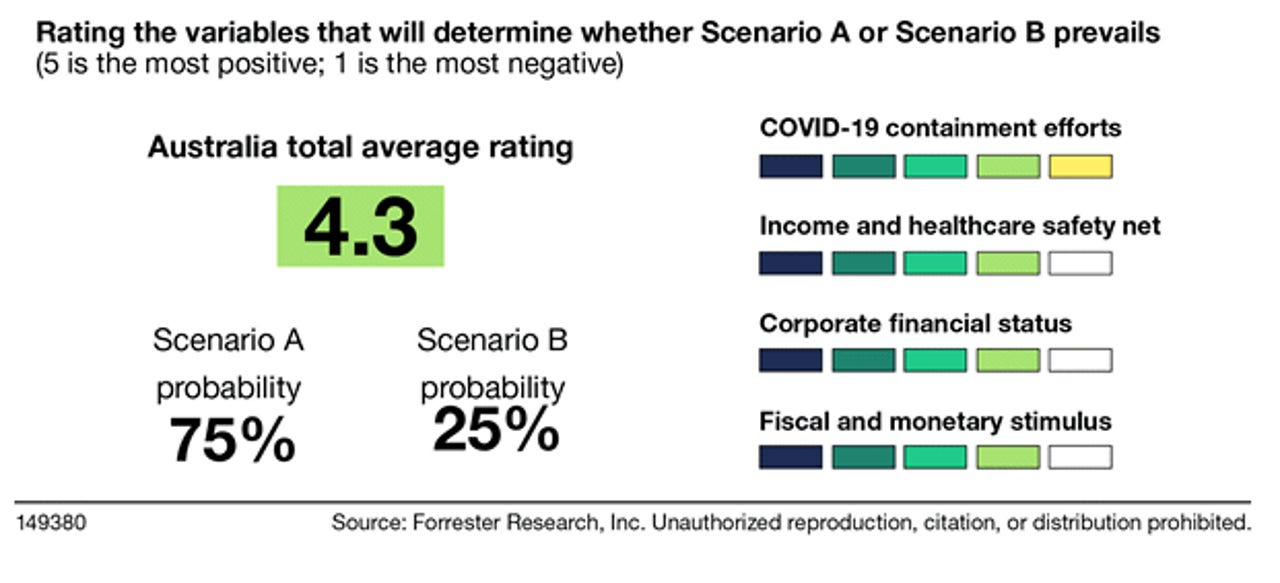Forrester predicts tech spend to shrink as Australia enters into recession

Forrester has revised its tech spending forecast for the Australian market, believing it will shrink in 2020 as Australia enters a recession for the first time in 29 years.
The research firm said it has developed three scenarios -- all in which Australia's tech spend will decline -- off the back of the International Monetary Fund (IMF) forecasting the nation's real GDP will fall by 6.7% in 2020.
"There's no question that Australia will experience a recession in 2020 -- so it's certain that local tech budgets will be cut. The only question is how deep and long-lasting the recession will be and how much tech budgets will shrink as a result," the research firm said in its tech market outlook report for 2020 to 2021.
In its first scenario, Forrester said Australia's tech spending could slump by around 3% in 2020, before it rebounds to positive growth of 4.5% in 2021, which is similar to 2019 spend levels. It added that software spending growth would lead the tech recovery.
Forrester then proposed that Australia's tech spend would fall by 6.4% in 2020, and recover by less than 2% in 2021 -- wiping out three years of local tech spending growth to the tune of AU$4 billion.
In this second scenario, Forrester believes software and services spending would slump, while hardware and telecommunications would suffer less, and therefore would more likely come back online first.
"This prediction takes into account a lag in local recovery due to delays in economic activity from Australia's major trading partners. We also consider the potential for a drop in economic confidence, resulting in lower consumer spending and business investment," the report said.

Scenario A seems the most likely.
Forrester labelled a final scenario as "even more dangerous", pointing out it would only occur if the coronavirus pandemic recurs and results in an economic downturn that extends well into 2021.
"We consider this worst-case scenario a bleak but remote possibility, and therefore have not modelled it," Forrester said.
Similarly, GlobalData said its latest report into enterprise IT investment trends in Australia for 2020 revealed that about a third of Australian IT enterprise decision-makers have claimed their tech budgets would decline by about 10% due to the aftermath of COVID-19.
Another 16.7%, according to the report, indicated that their tech budget would decline by more than 20% after the coronavirus outbreak.
The survey further revealed that while the majority of enterprises will be restraining their tech spend, 30% of enterprises would still be increasing their IT budgets slightly or significantly.
"While Australia has been relatively successful so far in containing the COVID-19 outbreak and is beginning to relax lockdown measures, several business enterprises in the country are still reeling under the uncertainty created by what can now be termed as a global pandemic," GlobalData technology analyst Saurabh Daga said.
Last month, Gartner predicted tech spending in Australia in 2020 will dip by 6% to just under AU$88.8 billion, blaming the slow down on the coronavirus outbreak.
Related Coverage
Gartner predicts COVID-19 to slow Australia's tech spending by 6% in 2020
The pandemic is also impacting IT job ads.
Gartner predicts Aussie tech spending to reach nearly AU$100b this year
Expecting spend to tip AU$103 billion in 2021.
IT budgets 2020: How the money will be spent, and who will spend it
IT budgeting is challenging at the best of times, but for 2020 an extra helping of political and economic instability -- possibly even global recession -- will make things even harder for CIOs.
Hardware to consider adding to your 2020 IT budget
Learn how to determine which hardware to include in your 2020 IT budget and how to calculate your organization's hardware costs.